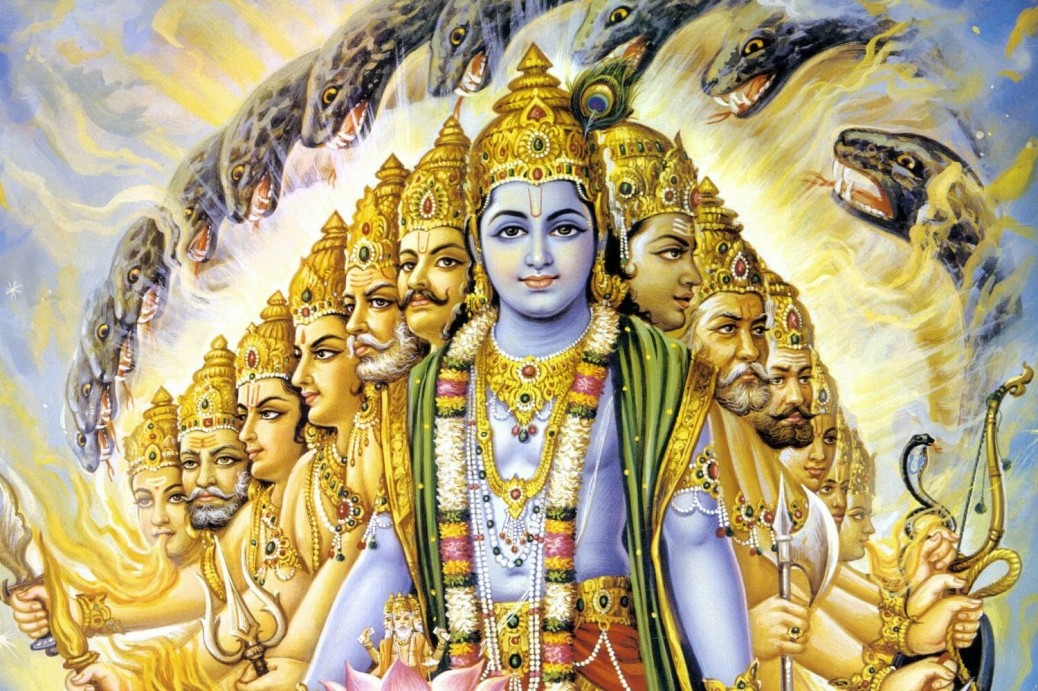Form To Formless – In Gita Verse 7.24 Unintelligent men, who do not know Me perfectly, think that I, the Supreme Personality of Godhead, Kṛṣṇa, was impersonal before and have now assumed this personality. Due to their small knowledge, they do not know My higher nature, which is imperishable and supreme.
Krishna says that a divine incarnation means – that the formless has assumed a shape and a form, that the infinite has chosen to show you a tangible, bodily form. It seems self-contradictory, but this is what a divine incarnation is. A divine incarnation is a sort of platform from where you can see the vast sky. A divine incarnation is a glimpse of the formless. You cannot have direct contact with the formless – the experience of it will be through some form. And once this happens, the experience can be repeated through that form again and again very easily.
What are the principles involved in the use and worship of an idol? Firstly, in order to jump into the ultimate truth for which you are searching, you need some solid ground, a jumping board. The ultimate truth does not need any solid ground, but you need a place from where to set out, from where you can take a jump. You have set out to jump into the ocean, and the ocean is infinite – you will need a shore or coastline from where you can take the jump. Until you jump, where else could you be except on the shore? Once you jump you will have left it behind – but will you not look back to thank the shore from where you jumped into the infinite?
It seems contradictory: how is it possible to jump from form to formlessness? If you are going to be rational about it, then the statement is wrong. How can form lead to the formless? Form should only take you to a deeper form. If you asked Krishnamurti, he would say it is impossible. How can you jump from form to formlessness? How can you jump from the word to the wordless?
But no, all jumps are from form to formlessness because deep down, form is not the opposite of formlessness, but only a part of it – and an indivisible part. It may seem separate to us because of our limited vision, but in fact, form and formlessness are indivisible.
When we are standing on the shore, looking at the ocean, we feel that they are separate; and that this shore and the opposite shore, far across the ocean, are also separate. But if we go deep underneath the water, we will see that this shore and the opposite one are connected at the bottom of the ocean.
If we think in the language of science, there is a very interesting fact: along the bottom of the whole ocean is mud or sand, if we dive into the ocean we will find sand; if we dig into the land, we will find water. Expressed in scientific terms, we could say there is more water and less mud in the ocean, and there is more mud and less water on the land. The difference is only a difference of proportion, of degree, they are not actually separate – everything is one and united.
Whatever we describe as having form is united with the formless; and the formless too is united with form. We are standing in form – and the concept of the idol accepts the fact that we are standing in form. This is the situation, this is where we are; and we can only begin our journey from where we are, not from where we have to reach. Many philosophies begin from where we should ultimately be – but how is it possible to begin a journey from where we are not? The journey has to begin from where we are.
And where are we? We are living in form. All our experiences belong to form, to the manifest. We have not known anything that is not manifest, that does not have a form. If we have loved, we have loved a form; if we have hated, we have hated a form. All our attractions are related to form, and all our repulsions are related to form. Our friends and enemies are all in form; whatsoever we do is done with form.
The original understanding about religious statues and idols accepts this fact; so if we are to set out on our journey to the formless, we will also have to give the formless some form. Of course, that form will be according to our own likings.
The art and science of making a religious statue consists of many concepts and calculations. If these are remembered while making the statue, then that statue can lead you deeper into meditation. In this connection it will be good to remember two or three things.
If you have seen any of Buddha’s statues, you will have observed that they represent a certain state of being rather than a particular individual. If you look deeply at a statue of Buddha, within a few moments you will feel that great compassion is showering on you from all around. Buddha’s raised hand, his half-closed eyes, his proportionately sculptured face, his graceful expression, his delicate way of sitting – all are in some deeper sense meant to evoke compassion in you.
An ignorant, unconscious, unintelligent person even when they are worshiping idols, their whole worship is to fulfill the requirements of the objective world. So even when any divinity takes birth what we call as incarnation at that time the ignorant will miss him. As his whole focus is on the form, objective world.
In my Bhagavad Gita Verse 7.23, I wrote that an ignorant person’s prayer is a demand and for a self-alert person the same prayer is resurrection.
Krishna says that even when I take birth an ignorant person cannot recognize imperishable and supreme in me.
Tags: Form To Formless




